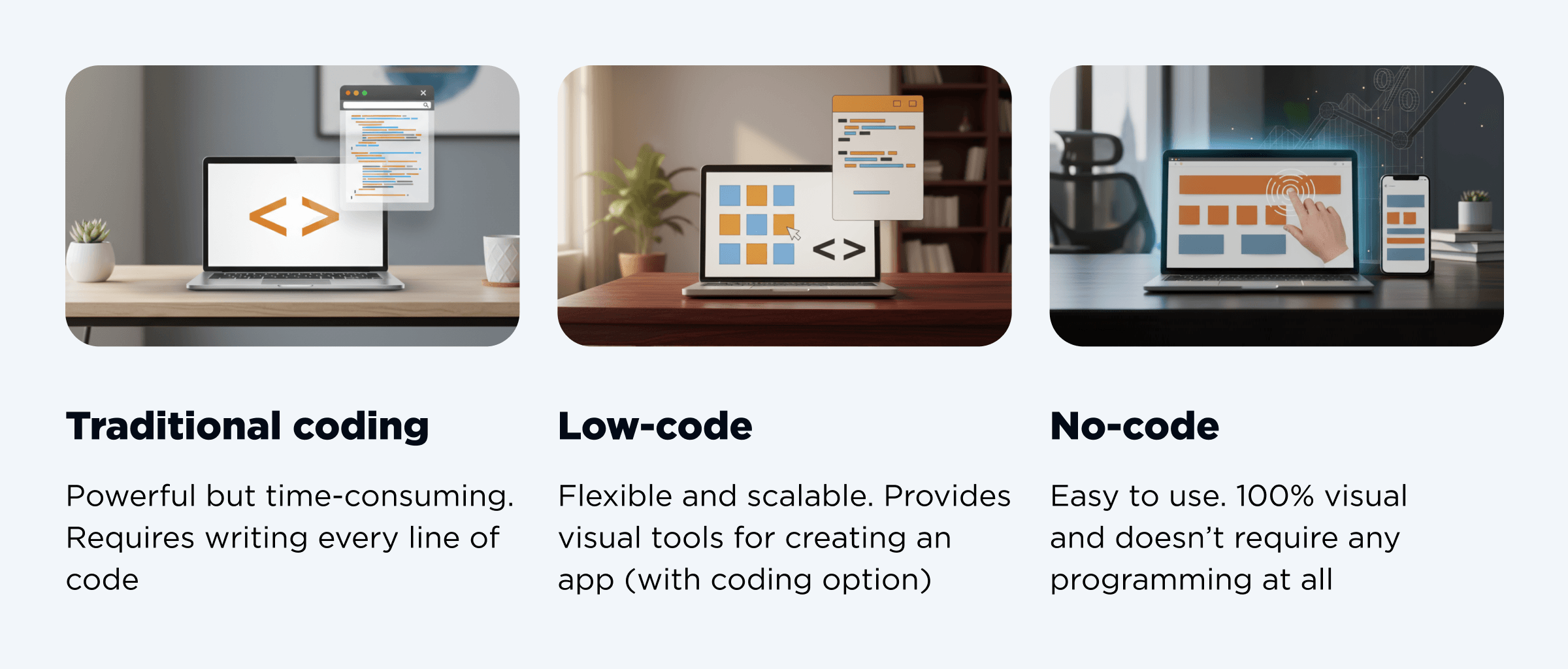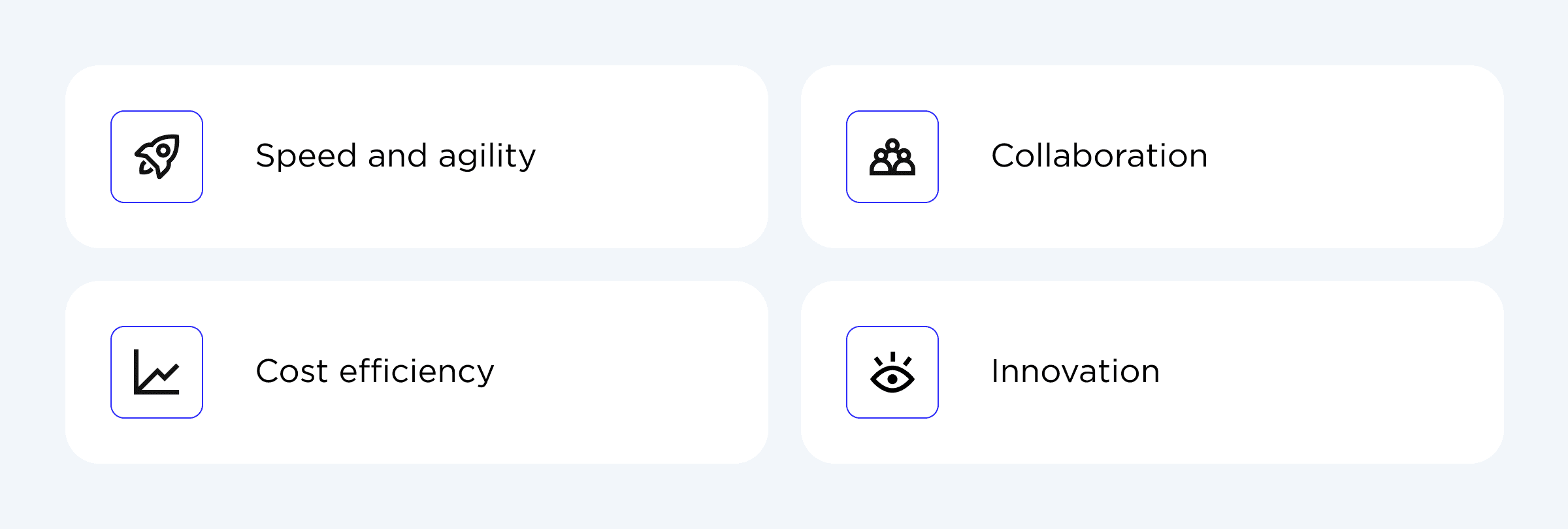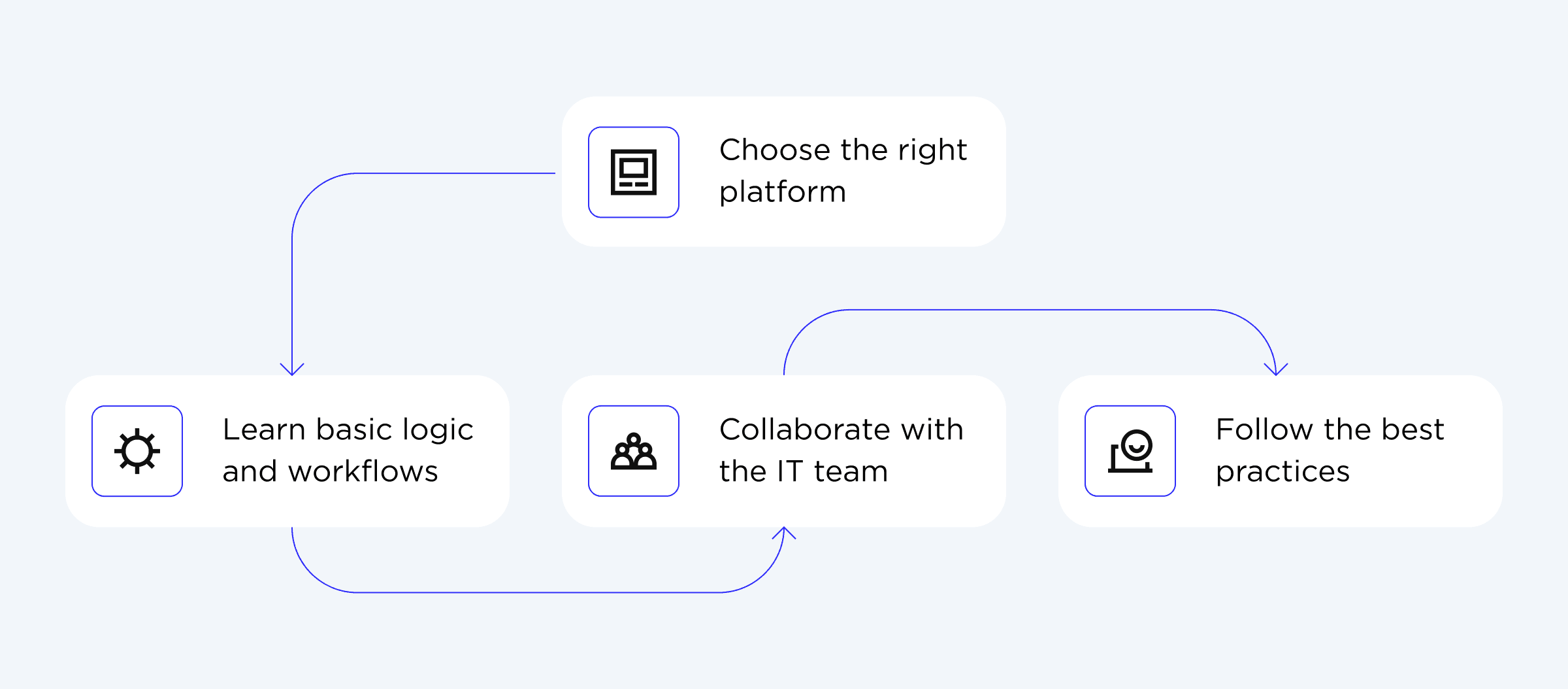Every business owner, start-up founder, or the one in charge always thinks of the process of building an application as something challenging, developer-requiring, and costly. What if I tell you that you can create an app without being a coder? Sounds wild, right? Well, that’s the reality! The world has changed, and it is heading toward low-code development in 2025.
Let me be clear, it is not some buzzword nor is it a joke. This is a new standard that makes it possible for people from management, marketing, HR, finance, operations, and the like to design and launch applications without writing thousands of lines of code or even without knowing how to do that. To put it simply, low-code software development is going mainstream.
Here’s the kicker: according to Gartner, about 70–75 percent of all new enterprise apps are expected to be built with low-code or no-code platforms by 2025 (just to compare, in 2020, this percentage was around 25%).
Spoiler alert! Low-code development is not just about building faster but about building smarter and with more freedom.
I’m not trying to say that “Okay, now we don’t need any developers!” No way! They are still the gatekeepers of digital products. Moreover, they may be needed when so-called citizen developers step in. However, the best part of low code is that it decreases the barrier to entry. The rise of “citizen developers”, who create apps using drag-and-drop tools, can make it easier for companies to innovate and react to different challenges.
In this article, I’ll walk you through the concept of low code, the most common platforms, the benefits, and what it really means for non-tech professionals. Buckle up and let’s go!
What Is Low-Code Development?
To start with, I’d like to give the definition of low-code development.
Low-code is a software development approach that involves using a visual interface with drag-and-drop components, pre-built templates, and logic-based workflows. This approach provides for designing and deploying applications with minimal hand-coding.The best things about such development methodology are that its users can build functional, scalable, and powerful apps by combining graphical modeling tools and limited scripting or configuration. It eliminates the need to write lines and lines of traditional code from scratch.
But if you ask me, “What is low code in simple words?”, I’d say that it’s like assembling Lego blocks. No jokes! It does remind this: you drag, drop, connect, and you get an app that comes to life.
We’ve all heard about traditional coding. Now, I’m trying to dive into the specifics of low code. But what about the no-code approach? Let’s break it down.

I hope this visualization has shed some light on the main differences between those three approaches. But, going back to low code, there are many platforms that have become the go-to tools for all types of businesses. Mendix, Microsoft Power Apps, OutSystems, Salesforce platform, etc. ( available through Google Cloud Platform). They provide control, scalability, speed, and flexibility without draining IT budgets. How do you choose what platforms suit you best? I’d recommend reading the article below and discovering more about trending low-code platforms yourself.
What is the main power of low-code? It cuts the “distance” between an idea and a final product. Imagine that your customer support team has to cope with hundreds of repetitive ticket updates on a daily basis. They can just log into a platform, drag some components, and use robotic process automation to automatically route tickets. The built-in AI can analyze it on topic or urgency. Results? Your team has more time for real problem-solving while you significantly improve customer experience.
Still doubting whether to try it? Let’s move on then!
Why Non-Developers Are Turning to Low-Code
Everyone wonders, “Why use low code?”. It’s as simple as that! Businesses develop at the speed of light. More and more new digital products appear on the market daily. Software teams simply cannot keep up. Moreover, there are some common pain points:
- long queues for app requests,
- developer shortages,
- hours of testing,
- endless maintenance, and the like.
Low-code developers step in here and confidently say, “We’ve got this!” So, what are the reasons non-tech teams opt for low code? Let’s discover.
- Business needs are growing faster than IT capacity
Companies constantly need new digital tools (be it internal dashboards, workflow automation, CRM extensions, etc.). It is hard to find so many skilled developers because the demand outweighs the supply. That is where low-code can fill in the gap. - Time-to-market matters more than ever
Even one week or a few days of delay can bring losses in revenue or customers to a competitor. When using low-code platforms, your non-tech teams can create prototypes, test, and deploy in no time. You can save weeks or even months. - Empowerment of non-tech teams
It is important for your marketers, analysts, and even accountants to take control. They don't need to wait for IT. Instead, they can experiment with apps and workflows on their own. When they bring new ideas to life, it’s another level of achievement.
Basically, low code gives innovation tools for your non-developers. Isn’t it what all companies need?
Key Benefits of Low-Code for Non-Technical Users
As I’ve already covered why to use low code, let’s explore the “what it has for you” part.

Speed and agility
Low-code app development can significantly reduce delivery times. No more months of coding and testing. Instead, you can build and launch a usable app in weeks or days. Thanks to ready-to-use components, you can quickly assemble what you need. Moreover, when you need to update something later, you can just open an editor, make changes, and publish. No complicated tweaks.
Cost efficiency
There’s no surprise when I say that hiring developers can be pricey. Especially when you need custom development. And it is fair as their job is not easy and requires profound knowledge. However, not every task requires such a high level of coding. This way, when your business needs a simple app, it can save up to 40-60% on project costs by using low code.
Collaboration
We do have project managers who bridge the gap between clients and developers. Low code is the same bridge, but between business departments and IT. Everyone involved can see what has been built and what is being built. Businesses become more aware of the logic, and developers know when to step in. It adds up to team morale, and everyone starts speaking the same language. It significantly enhances transparency, reduces misunderstandings, and improves the overall user experience.
Innovation
It may be difficult to experiment when building an app takes months. However, with a low-code approach, creativity advances drastically! No one is afraid to try new ideas anymore. Why? Because it doesn’t cost you an arm and a leg and takes a matter of days to test new tools. If something doesn’t work, you can always delete and try building it differently. This is how innovation gets encouraged.
Challenges and Limitations Low-Code Might Bring About
Even though almost anyone can become a low-code developer, nothing is perfect, and low code is not a cure-all or a magical tool. There are a few things you should keep in mind.
Platform lock-in
App development is not a linear process. And, unfortunately, some platforms can make it hard to migrate later. You should be careful when you choose a platform and consider your long-term goals. Because when you start, you can be tied to the ecosystem, tools, and even pricing. What to pay attention to? Always beware of export options and whether a platform supports open APIs.
Security and governance
I don’t want to seem rude. However, when you give non-tech teams full access to creating apps, there may be a bit of chaos if the process is not well-managed. That is why I keep mentioning the need for IT oversight and not the complete elimination of traditional coding. Even low-code app development requires governance tools (version tools, audit trails, permissions, etc.) and security compliance (access controls, encryption, etc.).
Not replacing developers completely
If you have expectations of full replacement of developers, please forget about it. It is all about case management, of course. However, developers are needed to support non-tech employees. Moreover, when it comes to architecture, integrations, and maintenance, no one can replace them. The whole idea is about letting developers handle the hard stuff while non-developers can handle the rest.
When there is nothing to worry about? Only when everyone plays their part, the system runs smoothly and efficiently.
How to Get Started as a Non-Developer
Have you already made up your mind to try low-code yourself? I must note that’s a good call. But where do you start low-code development? Don’t worry. I have your back. Let’s explore a practical roadmap.

Choose the right platform
You should pick the platform that fits your goals and preferences. For example, if your company is already using Office 365, opt for Microsoft Power Apps, because it’s the best match for internal tools. If your infrastructure runs on Google Cloud, AppSheet or similar low-code tools can seamlessly integrate with your existing workflows. If you need a solution for internal dashboards or admin panels, Retool is a good option. When you run an enterprise, select Mendix or OutSystems, which are amazing for scalable apps. Also, remember to compare pricing, interactions, and the learning curve.
Learn the basics of logic and workflow
I’m not saying you must learn JavaScript or something. However, you do need to understand and learn (if you don’t) basic logic and workflows. And I have good news for you! If you can easily handle Excel formulas and know how to build automations in Zapier, you’ve already covered halfway there.
Collaborate with IT
Let me put it clear - IT is not your enemy. Remember, they are your lifebuoy. You don’t need to ask them and clarify every step on the way. However, make sure that you work together. They are here to ensure the right governance, security compliance, and performance optimization. Don’t go rogue. Rather, consider it as co-building.
Follow only the best practices
It is crucial to follow low-code best practices when you get started. What are they, you might ask?
- Always keep your app simple. You can always expand and scale up.
- Start testing with real users as early as possible.
- Remember to document your workflow.
- Even when starting simple, make sure to plan for scalability.
When you follow these steps, you can smoothly build something that lasts.

Curious how low code could work for your business?
CONTACT USThe Future of Low-Code Development
After everything you’ve read, I should say that it’s just a warm-up phase of low-code software development. This approach is getting bigger, and there are many things on the horizon to expect.
- AI-assisted application creation
As you may know, AI is already starting to write code, fix bugs, and even suggest workflows. In the future, we’ll be able to describe what we need (like “I need an app for meeting scheduling”), and AI-powered systems can build it automatically. - Broader enterprise implementation
Good news: big companies are no longer skeptical about low-code. These platforms already support enterprise-level scalability, compliance, and integrations. Soon, we can expect various corporations to start implementing digital products with low-code. - Increase in hybrid development
We’ve already entered the era where there’s a thin line between “developer” and “non-developer”. As even marketing managers can build apps, software developers must get involved to fine-tune them. The future holds a hybrid approach where everyone contributes.
Why use low code? Well, I don’t want to scatter words. But we all should be ready to understand that conducting software development in 2030 will be as easy as making a PowerPoint presentation today. The entry barriers are decreasing fast, and low-code is leading the dance.
Wrapping Up: Why Opt for Low Code
Digital transformation has taken its toll. I’m not exaggerating when I say that low-code app development is a movement nowadays. This, on one side, simple tool is changing the way we think about software, creativity, and collaboration.
Back in 2018, probably, the main question was who could code. In 2025, it is about who can create. Drum roll! Almost anyone can make it happen thanks to low-code platforms. Your financial specialist needs to automate reports? Low code! Your HR team require onboarding tools? Low code! Your procurement department is looking for supply chain automation products? Low code! Your marketing team is in need of internal dashboards? Again, low code. All simple and sometimes complex software solutions can be made with little or no coding skills.
Does your company want to catch the wave? In this case, our OTAKOYI team is here to help and guide you. We have experience in helping businesses implement various low-code solutions. All of them aim to save time, cut down expenses, and empower non-tech employees to innovate the way they see it. So, are you ready to make your whole team unstoppable?







